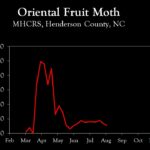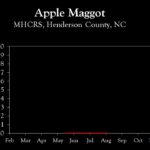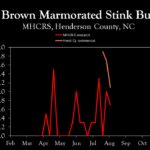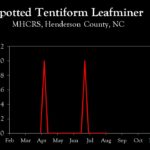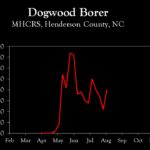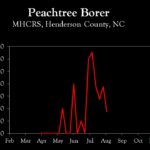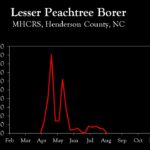WNC Orchard Insect Pest Populations – August 8, 2023
go.ncsu.edu/readext?950043
en Español / em Português
El inglés es el idioma de control de esta página. En la medida en que haya algún conflicto entre la traducción al inglés y la traducción, el inglés prevalece.
Al hacer clic en el enlace de traducción se activa un servicio de traducción gratuito para convertir la página al español. Al igual que con cualquier traducción por Internet, la conversión no es sensible al contexto y puede que no traduzca el texto en su significado original. NC State Extension no garantiza la exactitud del texto traducido. Por favor, tenga en cuenta que algunas aplicaciones y/o servicios pueden no funcionar como se espera cuando se traducen.
Português
Inglês é o idioma de controle desta página. Na medida que haja algum conflito entre o texto original em Inglês e a tradução, o Inglês prevalece.
Ao clicar no link de tradução, um serviço gratuito de tradução será ativado para converter a página para o Português. Como em qualquer tradução pela internet, a conversão não é sensivel ao contexto e pode não ocorrer a tradução para o significado orginal. O serviço de Extensão da Carolina do Norte (NC State Extension) não garante a exatidão do texto traduzido. Por favor, observe que algumas funções ou serviços podem não funcionar como esperado após a tradução.
English
English is the controlling language of this page. To the extent there is any conflict between the English text and the translation, English controls.
Clicking on the translation link activates a free translation service to convert the page to Spanish. As with any Internet translation, the conversion is not context-sensitive and may not translate the text to its original meaning. NC State Extension does not guarantee the accuracy of the translated text. Please note that some applications and/or services may not function as expected when translated.
Collapse ▲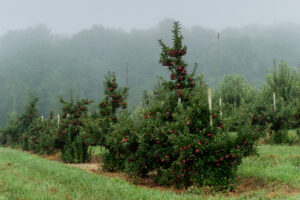 We are approaching that time of the year when codling moth and oriental fruit moth (OFM) populations become less important, and when the risk of damage by brown marmorated stink bug increases.
We are approaching that time of the year when codling moth and oriental fruit moth (OFM) populations become less important, and when the risk of damage by brown marmorated stink bug increases.
Codling moth has or is near completion of the 2nd generation throughout the region, and OFM has completed its third generation. While there is time for another generation of each insect, the risk of damage from hereon is low in those orchards that have not experienced problems up to this point in time. In those orchards that have experienced infested fruit, the risk is likely to remain into September.
Overlapping generations of OFM can lead to increased populations in August and September. In the past this was often avoided with an application of sprayable OFM pheromone (CheckMate OFM-F) in mid August and early September, but increased use of pyrethroids for BMSB (see below) has led to suppressed late-season OFM in recent years.
Brown marmorated stink bug DD accumulations in Cleveland, Wilkes and Henderson County average about 900, 708, and 694, respectively. Based on the model predicting emergence of F1 adults, emergence is about 35-40% in Cleveland County, so risk for damage is high. However, BMSB populations have been relatively low this year, so the risk factor is likely lower.
Initial emergence of F1 adults occurs at about 750 DD, which is predicted to be early next week in Henderson and Wilkes Counties.
Finally, remember that the Mountain Hort Field Day is this Thursday, August 10, at the Mountain Horticultural Crops Research and Extension Center in Mills River. This field day includes several apple presentations in the research orchards as well as talks on tomatoes, vegetables, specialty crops, and alternative crops. More details are in the MHCREC announcement.
Learn more about southeastern apple insect pests at the Apple Insect Management page.
2023 Average Weekly Trap Captures
| HENDERSON COUNTY | |||
| Insects per trap | |||
| July 24 | Aug 1 | Aug 8 | |
| Codling moth | 1.0 | 4.5 | 1.0 |
| Oriental fruit moth | 18.0 | 13.5 | 11.0 |
| Tufted apple bud moth | 0.0 | 1.0 | 0.0 |
| Redbanded leafroller | 0.0 | 0.0 | 0.0 |
| Obliquebanded leafroller | 0.0 | 0.0 | 2.0 |
| Lesser appleworm | 0.0 | 1.0 | 0.0 |
| Apple maggot (abandoned and research orchards) | 0.0 | 0.0 | 0.0 |
| Brown marmorated stink bug (commercial) | 1.9 | 1.7 | 1.1 |
| Brown marmorated stink bug (unsprayed) | 0.0 | 1.0 | 0.7 |
| Spotted tentiform leafminer | 0.0 | 0.0 | 0.0 |
| Dogwood borer | 17.0 | 11.0 | 20.0 |
| Peachtree borer | 5.5 | 7.5 | 3.5 |
| Lesser peachtree borer | 3.0 | 2.5 | 0.0 |
| San Jose scale | 15.0 | 0.0 | 0.0 |
*Note that these averages illustrate only the timing of insect emergence and fluctuations in populations, and are not representative of population levels in any given orchard. The only way to have an accurate assessment of an individual orchard’s populations is to set up traps in that orchard.
2023 Accumulated Degree Days
| HENDERSON COUNTY | ||||
| July 24 | Aug 1 | Aug 7 | ||
| Codling moth (Biofix: April 7) | 1605 | 1802 | 1938 | |
| Oriental fruit moth (Biofix: March 24) | 2275 | 2506 | 2673 | |
| Tufted apple bud moth (Biofix: April 21) | 1922 | 2153 | 2320 | |




